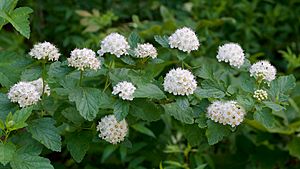Physocarpus opulifolius facts for kids
Quick facts for kids Physocarpus opulifolius |
|
|---|---|
 |
|
| Inflorescences | |
| Scientific classification | |
| Genus: |
Physocarpus
|
| Species: |
opulifolius
|
Physocarpus opulifolius, often called common ninebark, is a cool plant from the rose family. It grows naturally in eastern North America. People also call it Eastern ninebark or Atlantic ninebark.
What Ninebark Looks Like
Ninebark is a bushy plant that loses its leaves in winter. It grows in a rounded shape. Its stems arch outwards, and its leaves grow one after another along the stem.
This shrub can grow from 1–3 m (3–10 ft) tall. It can spread out about 1–2 m (4–6 ft) wide. Its leaves are about 3–12 cm (1–5 in) long. They have several parts that spread out like fingers from the center.
Ninebark grows quickly. It is also strong against bugs and diseases. It can handle dry weather well. This plant can grow in many different places. It likes soil that is wet or dry, and it can grow in sunny or partly shady spots.
Its flowers have five petals and are about 6–8 mm (0.24–0.31 in) wide. They grow in clusters called corymbs. The flowers are white or a little pink. They bloom from May to June in North America. In Missouri, the fruits become ripe from August to early October. These fruits are small, dry pods. They hang in papery clusters.
The bark of the ninebark plant peels off in thin strips. These strips look a bit like the number nine. This is how the plant got its common name!
Where Ninebark Grows
Physocarpus opulifolius is found in eastern North America. It likes rocky hillsides and stream banks. You can also find it in wet, bushy areas. It is especially common in counties south of the Missouri River.
There is also a similar type of ninebark in the Rocky Mountains and the Pacific Northwest. The plant's natural home stretches from New York to Minnesota and South Dakota. It goes south to Florida, Arkansas, and Kansas. You can find it from Quebec west to Minnesota, South Dakota, and Colorado. It also grows south to Oklahoma and Georgia, and north to New York. Sometimes, you might see it growing wild in the northeast. This happens when plants that were once grown in gardens escape and start growing on their own.
How We Use Ninebark
Ninebark can grow in tough conditions. This makes it great for stopping soil from washing away on banks. People also grow it because its leaves look pretty.
Many different types of ninebark have been created for gardens. Some popular ones are 'Dart's Gold', 'Diabolo', and 'Lady in Red'. These types have won awards, like the Royal Horticultural Society's Award of Garden Merit. Newer types of ninebark have different colored leaves. Some also grow to be smaller plants.
Nature's Friends
Ninebark is a very important plant for some insects. It is a "larval host" for them. This means that the young insects (larvae or caterpillars) eat its leaves.
Here are some of the moths that use ninebark as a host plant:
- The dimorphic eulithis
- Macaria abruptata
- The white spring moth
- Ancylis spiraeifoliana
- The blinded sphinx moth
- Possibly the bluish spring moth
Caterpillars of the raspberry leafroller have also been seen eating ninebark leaves.


